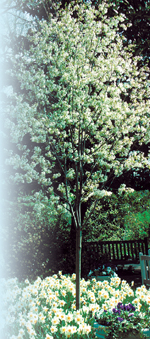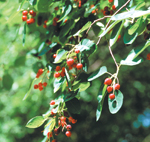Serviceberry, Drought-Tolerant Tree for North Carolina
go.ncsu.edu/readext?236376
en Español / em Português
El inglés es el idioma de control de esta página. En la medida en que haya algún conflicto entre la traducción al inglés y la traducción, el inglés prevalece.
Al hacer clic en el enlace de traducción se activa un servicio de traducción gratuito para convertir la página al español. Al igual que con cualquier traducción por Internet, la conversión no es sensible al contexto y puede que no traduzca el texto en su significado original. NC State Extension no garantiza la exactitud del texto traducido. Por favor, tenga en cuenta que algunas aplicaciones y/o servicios pueden no funcionar como se espera cuando se traducen.
Português
Inglês é o idioma de controle desta página. Na medida que haja algum conflito entre o texto original em Inglês e a tradução, o Inglês prevalece.
Ao clicar no link de tradução, um serviço gratuito de tradução será ativado para converter a página para o Português. Como em qualquer tradução pela internet, a conversão não é sensivel ao contexto e pode não ocorrer a tradução para o significado orginal. O serviço de Extensão da Carolina do Norte (NC State Extension) não garante a exatidão do texto traduzido. Por favor, observe que algumas funções ou serviços podem não funcionar como esperado após a tradução.
English
English is the controlling language of this page. To the extent there is any conflict between the English text and the translation, English controls.
Clicking on the translation link activates a free translation service to convert the page to Spanish. As with any Internet translation, the conversion is not context-sensitive and may not translate the text to its original meaning. NC State Extension does not guarantee the accuracy of the translated text. Please note that some applications and/or services may not function as expected when translated.
Collapse ▲
‘Amelanchier’
Photo by JC Raulston
The serviceberry (Amelanchier spp.) is a small tree or shrub with white airy blooms that make it a desirable landscape plant. In the Piedmont, Amelanchier arborea beats other spring beauties to the punch, blooming earlier than dogwoods and often earlier than redbuds.
The berries are the size and shape of a blueberry with a distinct taste and can be eaten fresh or used in pies and jams. If you prefer feeding wildlife, birds seem to consider the berries fine cuisine.
The species and most cultivars have good fall color which also contributes to its landscape appeal. Fall foliage varies from yellow to red. The smooth, grayish white bark of young trees and the reddish purple buds add winter interest.
When looking for this tree for your landscape, be aware that common names include serviceberry, sarvisberry, shadbush, shadblow and juneberry. Amelanchier is sometimes called a currant by people unfamiliar with real currants (Ribes sp.). The names can be confusing, but most named hybrids have A. arborea or A. laevis in their parentage. These perform well in North Carolina. A natural hybrid called A. x grandiflora is good for edible landscaping. A. alnifolia is a more northern species and won’t do as well in North Carolina.A. arborea is often incorrectly sold as A. canadensis, which is a small suckering shrub.

‘A. x spicata’
Photo by Todd Lasseigne
Amelanchier does well in full sun to partial shade and thrives in most landscape situations. In nature, A. arborea often grows on dry ridges with shallow soils which means it is drought tolerant once established. Insects usually are not a problem. Overfertilization may cause some Fire Blight. Rust may sometimes occur, which may reduce the yield but will not kill the plant.
At the JC Raulston Arboretum (JCRA), you will find Amelanchier ‘Princess Diana’ in the White Garden. The flowers are a fitting complement, to this garden devoted to the purest of colors. The White Garden is one of the most formal areas within the JCRA. To learn more, visit jcra.ncsu.edu.
David Goforth


